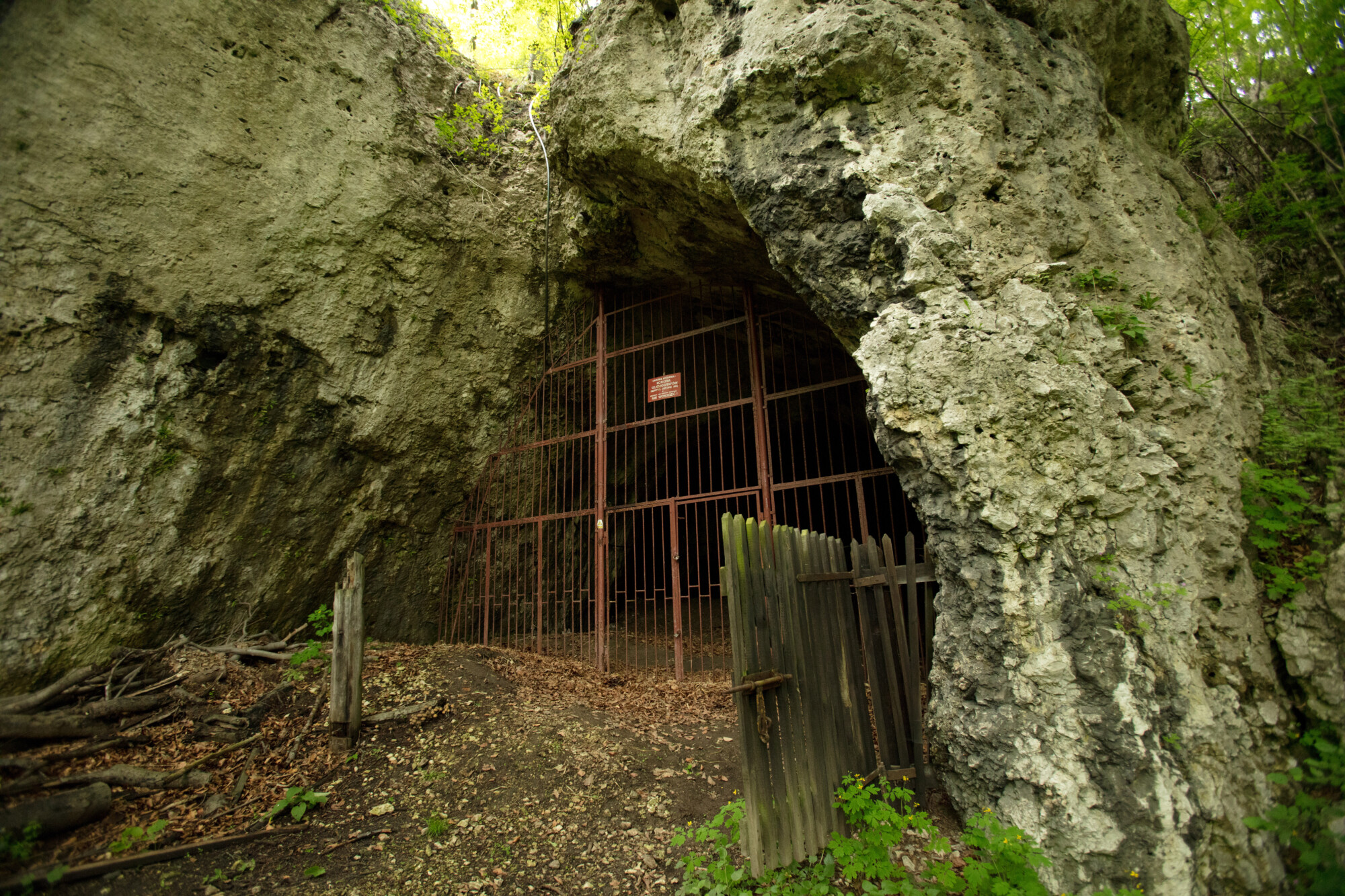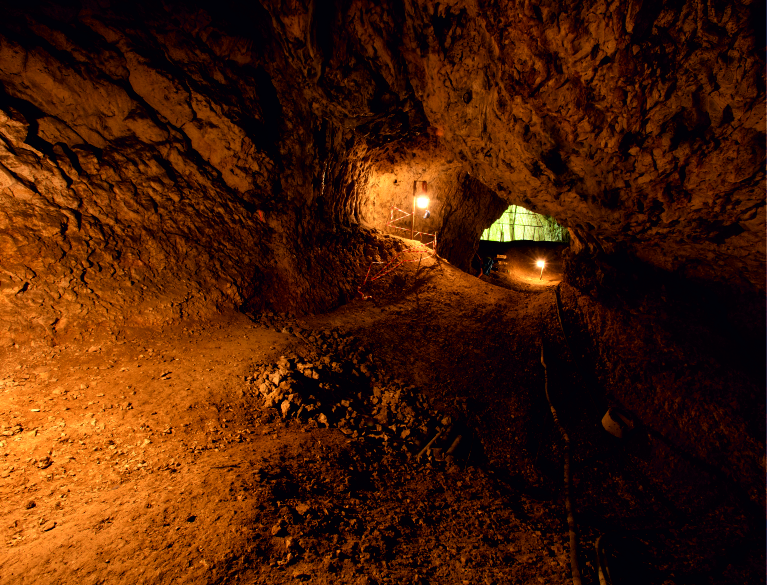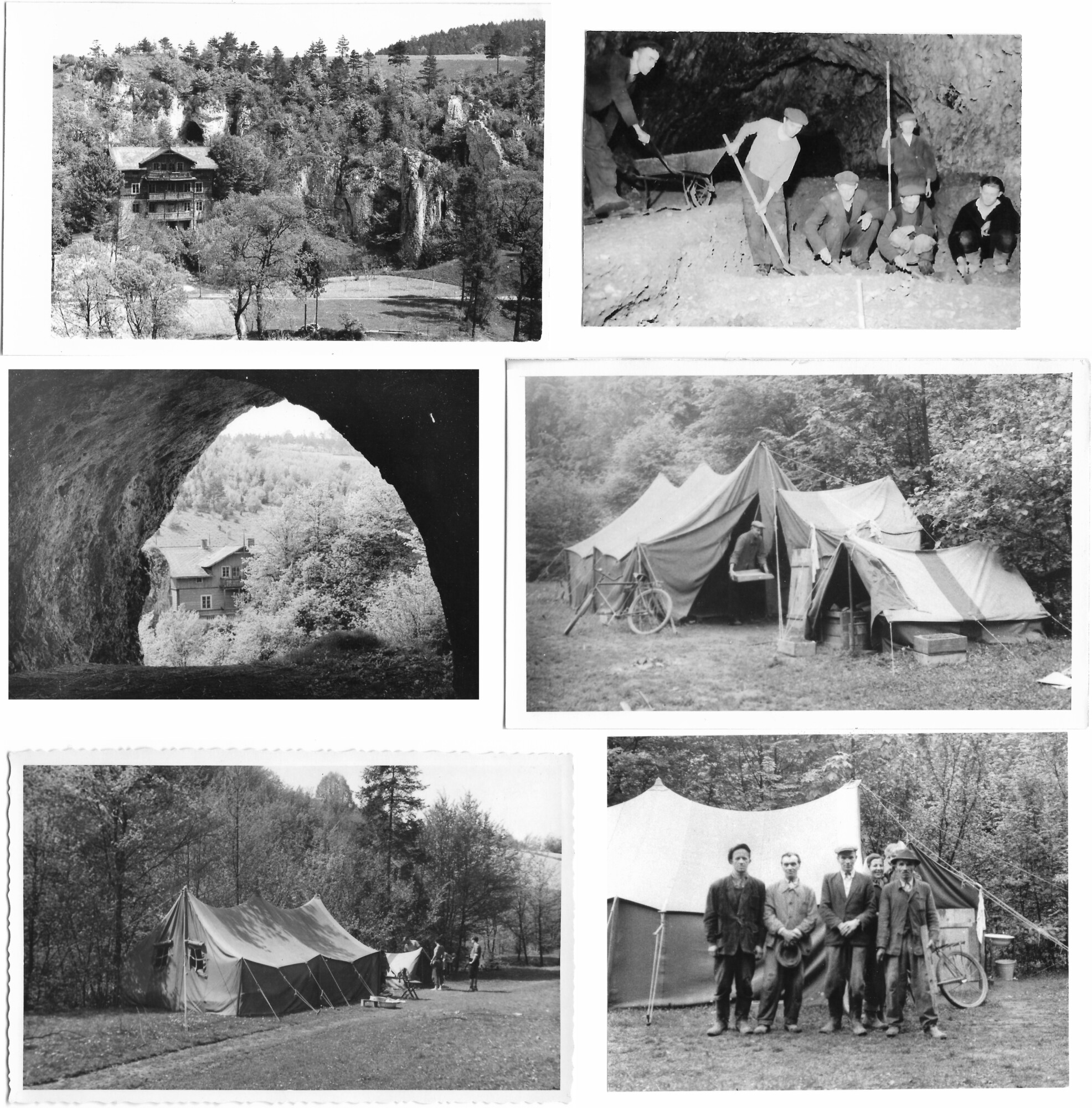This cave used to be a dwelling for the Neanderthals, a dance floor and a bowling club. In the past it was inhabited by humans and cave bears in turns. At some other time there was a pen for livestock. Hence the name – Koziarnia (goat barn)…

© M. Bogacki, CC BY-NC-SA 4.0 licence
I remember that when I was a teenager I stood in front of the barred entrance protecting the mysteries of Koziarnia Cave and thought: “I would really want to excavate this place”. I took my mum and brother there. We walked along the bottom of the Sąspowska Valley, when we passed the seismological observatory I suggested we turn into a dark and humid gully. Several dozen metres further on a dark shape emerged on the slope. It was hard to see anything from the spot in front of the bars, but imagination of a young lover of archaeology produced vivid images:
A group of hunters clad in animal skins cautiously approaches with torches and spear to check whether the place is safe, or perhaps there is a bear sleeping inside. A tired child clings to his mother’s leg and sobs. A thin boy climbs the steep slope with difficulty and carries heavy bundles. The cave is empty, they can come in. A fire at last and a good smell of roasted meat.
When I was standing at the entrance and pressed my face against the bars, I thought one of these people would step out of the dark space and let me in.

Koziarnia Cave – one of the best known archaeological cave sites in Poland, mainly due to the research conducted by Professor Waldemar Chmielewski in the late 1950s and early 1960s. Nevertheless, the site was known even earlier than that – from the time when in the late 19th century the sediment was sourced from the cave on a big scale and sold as fertilizer. The soil extracted from the cave contained incredible amounts of animal bones, mostly from the Pleistocene, which means they came from the so-called Ice Age (more than 20 thousand years ago). These bones soon became an object of interest to the German geologist and palaeontologist Ferdinand Roemer, who at that time was a lecturer at the University in Wrocław. It was 1879. Roemer was granted funds for his studies and launched excavations. As a palaeontologist, he was interested mainly in animal bones, but he did not ignore archaeological artefacts. In 1883 he published a book presenting the most significant discoveries. One of them struck Professor Chmielewski’s imagination 70 years later – a leaf-shaped bifacial flint point.
Professor Chmielewski came across a series of similar leaf points in the nearby Nietoperzowa Cave in the late 1950s. In 1957 he decided to start excavations also in Koziarnia Cave. His objective was simple: he wanted to check whether he would discover similar contents to those from Nietoperzowa Cave, that is, remains of a camp from approx. 40 thousand years ago, with more than 100 points or their fragments, as well as a huge hearth situated just next to the entrance inside. He associated the point and hearth with a great number of cave bear bones and hypothesized that Nietoperzowa Cave contained relics of bear hunting. The fire at the entrance was supposed to drive the animals out from the cave and the people waited outside for the bears running from the shelter filled with smoke. The points, which probably functioned as spearheads, were supposed to help the hunters to make the kill. This vivid image was attractive to the general public.
This means the aim was to verify whether similar hunting activity was practiced in Koziarnia Cave and whether hundreds of points, so-called leaf points, could also be found there. Why was it so important? The reason was very simple. The first groups of modern humans arrived in Europe exactly in this period: approx. 40 thousand years ago. But Europe was already populated, and had actually been populated for several hundred thousand years by Neanderthals. Interestingly, neither Neanderthals, nor modern humans used leaf points or any tools resembling them. Hence the question: who used these points for hunting in the area of Nietoperzowa Cave? Who left the point in Koziarnia Cave? Some of the last Neanderthals, or some of the first modern humans arriving in Europe?

© M. Bogacki, na licencji CC BY-NC-SA 4.0
After exploration of Nietoperzowa Cave, Professor Chmielewski prepared a description of the artefacts left by the hunters and assigned a new archaeological name to such an assemblage – he called them the Jerzmanowice culture (Nietoperzowa Cave is located in the village of Jerzmanowice). It was 1961. As the time went by, the discovery was associated with other similar finds in Germany and Belgium (so-called Ranisian), as well as in Great Britain (co-called Lincombian) and another name was coined, possibly the longest name of an archaeological culture: Lincombian-Ranisian-Jerzmanowician. (You should listen to our colleagues from Western Europe trying to pronounce it).
There was still a question yet to be answered, and it was not an insignificant one: who made these artefacts? The points were made of long flakes which we formally call blades. Neanderthals rarely produced blades and remodelled them into tools even more rarely. Then perhaps it was the modern human? Humans indeed formed almost all their tools of long blades. This type of flint processing was more efficient. However, leaf points or even similar forms are not known from the Near East, where humans migrated from, or from other later European sites. Modern humans generally did not produce tools processed on both faces, as opposed to Neanderthals. The latter developed a technique of bifacial processing (knapping) of flint material and the product was a tool, more precisely – a knife, with one sharp cutting edge end a pointed tip. It fitted the hand perfectly. It would not take much to develop such a knife into a point, the technology is comparable. Then perhaps it was really the Neanderthal? But why should he use blades? Blade technology corresponds with the modern human after all… and this is how you can ruminate about it forever.
Many great brains pondered over this puzzle, but the question remained unanswered. Archaeologists needed more sites, more artefacts, perhaps also human bones and some other evidence. All that just to reveal the mysteries of Koziarnia Cave…

Photos from the collection of the Archive of the Chair of the Stone Age, Faculty of Archaeology of the University of Warsaw, Public domain
Professor Chmielewski excavated Koziarnia Cave for five seasons. He opened trenches of a total surface area of 120 m2. He expected a lot to discover. After all, he had the point unearthed by Roemer. He knew there had to be something. But he found nothing. Well, definitely nothing that he was after. No points, no artefacts that could be associated with the Jerzmanowice culture. After a few years of exploration he was in no position to indicate the layer which would correspond with this period. Although one of them was practically black due to the content of charcoals, he found no artefacts in it. Eventually, he concluded that it might have been the Jerzmanowice layer by analogy with the big hearth in Nietoperzowa Cave. He unearthed very sparse artefacts in the deepest clay layers that could be associated with an earlier period: classic relics of a Neanderthal camp with bifacially processed knives and with flakes. I never had an opportunity to talk to Professor Chmielewski, but I believe he was deeply disappointed with Koziarnia Cave.
How come he was so unsuccessful? The methodology that he employed (I will discuss it in another article) was quite precise, considering the time when he worked. Most likely the history of the cave was the reason. In the early 20th century, the owner of the hotel called Szwajcaria, situated exactly on the opposite side of the gully, decided to develop the cave for the needs of his guests and built a bowling alley inside. A few years later he organized a dance floor in the biggest chamber, right next to the entrance. He also had benches and a small kiosk set up in front of the entrance.
A bowling alley? A dance floor? That’s right! Both required the levelling of the cave sediments . The ground surface prepared in this way was later covered with the wooden frames. There are surviving postcards showing a part of the dance floor, the benches and the kiosk outside. Would such a development cause any problem, you might ask. Yes, definitely – great problems.

People in pre-history, just like the hotel owner in question, naturally concentrated their activity in the area near cave entrances. This is where the most sunlight will penetrate, and the smoke from fires can escape out, so it is easier to avoid poisoning with smoke. It is also obviously drier and slightly warmer than deep inside the cave. The ceiling protects the inhabitants from rain. For this reason, we concentrate in the area of the entrance when we explore caves: we dig trenches in front of the entrance outside and just next to it inside. This is also where we find most artefacts.
In the case of Koziarnia Cave, all the sediments of the main chamber were destroyed in the early 20th century. Professor Chmielewski found the first relics of undisturbed layers only at the end of the main chamber, approx. 20 m from the entrance, in a zone which was almost completely dark. Chances to find artefacts in this portion of the site were very low. The Professor unearthed much more recent sediments on the terrace outside the cave than those that he was looking for. The oldest layers were 20 thousand years old at most, the oldest ones probably slid down along the course of gully. This means Roemer was lucky. He worked in Koziarnia before the sediments in the main chamber were destroyed. This is probably the area where the leaf point comes from. Professor Chmielewski and his researchers appeared on the scene too late. This is, unfortunately, quite common in archaeology. Interestingly, that was not the end of the turbulent history of Koziarnia Cave.
After the Professor finished his work, geophysicists went there, but not to continue archaeological research. They installed a seismometer in the deeper portion of the cave and converted the building of the Szwajcaria Hotel into seismological observatory. They closed the entrance with thick bars and took measurements for several decades.
And thus Koziarnia became an unverified site, where one leaf point was discovered in the 19th century. That is, until 2017… when we resumed exploration of this cave and raised the same questions as Professor Chmielewski did 60 years earlier. I will comment on our findings in the next part of the story.
This article can be re-printed with photographs free of charge provided that the source is cited.
Author:
Małgorzata Kot – an archaeologist. She is fascinated by Neanderthals as well as their relations with Denisovians and modern humans. She conducts her research in the western piedmonts of the Tian Shan in Central Asia. She also studies caves in the Cracow-Częstochowa Upland, which can reveal more interesting stories than just the secrets of the last Neanderthals.
https://www.researchgate.net/profile/Malgorzata-Kot
This text was funded by project entitled “From caves to public: A series of popular science articles published on the archeowieści.pl blog, showing a multidisciplinary approach in archaeology, based on the results of our researches in the Ojców Jura” from Inicjatywa Doskonałości – Uczelnia Badawcza programme. Research on the caves of the Sąspowska Valley was funded by the National Science Centre, project: SONATA BIS 2016/22/E/HS3/00486.
References:
Chmielewski, W., Kowalski, K., Madeyska-Niklewska, T., Sych, L.. Wyniki badań osadów jaskini Koziarni w Sąsowie pow. Olkusz, „Folia Quaternaria” 1967, vol. 26.
Kot M., Gryczewska N. (2021) Found in a box: unknown bifacial leafpoint from the Koziarnia cave. Fossile Directeur. Multiple perspectives on lithic studies in Central and Eastern Europe. Študijné zvesti Archeologického ústavu SAV – Supplementum 2: 19–30, doi: https://doi.org/10.31577/szausav.2021.suppl.2.2
Kot, M., Krajcarz, M.T., Hoyo, M.M. del, Gryczewska, N., Wojenka, M., Pyżewicz, K., Sinet-Mathiot, V., Diakowski, M., Fedorowicz, S., Gąsiorowski, M., Marciszak, A., Lipecki, G., Mackiewicz, P. Chronostratigraphy of Jerzmanowician. New data from Koziarnia Cave. Poland. „Journal of Archaeological Science: Reports” 2021, vol. 38, doi: 10.1016/j.jasrep.2021.103014
Editing: A.B.
Proof-reading: A.J.

2 Replies to “Mysteries of Koziarnia Cave. Part one – turbulent history of the cave”